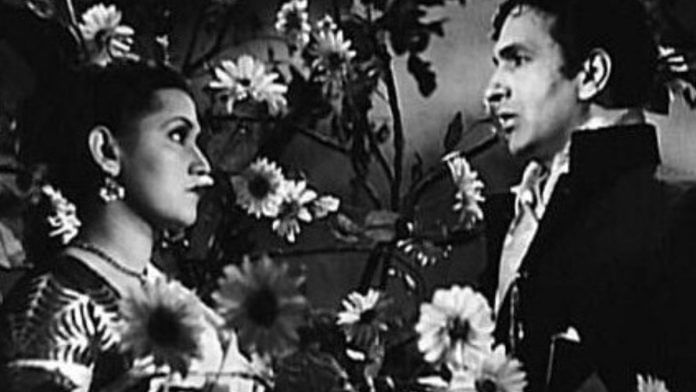The plot of childhood sweethearts who separate and spend their whole lifetime trying to find each other and find their way back into love used to be a sure-shot Bollywood hit formula. The classic novel Devdas has been made into several interpretations in Hindi cinema over the decades. Films like Laawaris (1981), Muqaddar Ka Sikandar (1978), Shola aur Shabnam (1961), Pyar ka Mausam (1969), Hum Kisise Kum Naheen (1977) have over the years followed this plotline. But, Mehboob Khan’s Anmol Ghadi (1946) was the first famous film that was cast in this mould. It evokes the innocence of a childhood bond that fortifies into an undying love and a lifelong yearning.
Anmol Ghadi is also remembered for two of its significant contributions to the industry. First, it cemented Mehboob Khan’s reputation as a filmmaker of mass appeal. Second, the film marked an early yet important milestone for Mohammed Rafi. His song ‘Tera Khilona Toota Balak’ became one of his first prominent hits.
It is a tale of longing for love, tragedy, and the passage of time. The narrative centres around Chander (Surendra), a young man deeply in love with his childhood friend, Lata (Noor Jehan). Their bond is symbolised by a pocket watch, a gift from Lata before they part ways.
Years later, Chander, now an employee in a small shop, comes across a book by the renowned poetess Renuka Devi, who is none other than Lata. Love is found, but just not in time.
The childhood friendship, separation, and sacrifice hit emotional chords during pre‑Independence India. And, the audience connected with its themes of unrequited love and longing.
Commercially, Anmol Ghadi was a blockbuster. It became the highest‑grossing Indian film of 1946 thanks to a powerful combination of musical brilliance, star appeal, and timeless romantic themes.
The pocket watch
One of the earliest and most emotionally charged moments is when young Lata gives Chander her father’s pocket watch as a memento before her family departs for Bombay.
It’s a watch holding Lata’s love in it and a symbol of the unbroken emotional bond between them. To reciprocate Lata’s gesture, Chander, too, wanted to give her a parting gift—a toy (which appeared like a doll). But, by the time he reaches, she is gone. So, Chander follows her car and in that attempt he trips on the road and the toy gets broken.
His attempted gift crushed, the metaphorical ‘toy’ broken. Here, the lyrics and Rafi’s voice add a layer of depth to Chander’s pain.
This scene anchors the emotional core of the story; it is what Chander’s longing and regrets will revolve around in the later parts of the film.
Another great scene is when Chander finds out that Renuka Devi is Lata. He had been waiting years and still had the watch.
The impact is made stronger because, at the same time, he also learns that Lata is about to marry his friend Prakash.
Suraiya steals the show
Noor Jehan, playing Lata and Renuka Devi, dominates much of the film through both her screen presence and her voice. She is beautifully captured in soft‑focus close‑ups, delivering emotional scenes with elegance.
Her solo scenes allow her to showcase a wide range of moods, be it longing and nostalgia to pain and quiet dignity. Critics note that her performance largely carries the sentimentality of the plot.
However, Suraiya, in the role of Basanti (Lata’s friend) , stands out even more for her energy and charisma. Her scenes are lively, her songs expressive, and she gives Basanti a personality that stands out rather than letting her be just the second lead.
Her character challenges or contrasts with Lata’s more refined persona.
And, by contrast, Surendra as Chander is underwhelming. He gets overshadowed by the leading women. The script’s melodramatic demands limit his emotional range, and his character, unfortunately, fails to rise above his weaknesses.
Also read: Aamne Samne is one of Bollywood’s best thrillers. Somebody’s out to kill Sharmila Tagore
Music: an emotional backbone
The music of Anmol Ghadi is one of the defining albums of Indian cinema. The composer Naushad and lyricist Tanvir Naqvi created 12 songs that move through feelings of childhood love, longing, pain, sacrifice, and nostalgia.
One of the strengths of the soundtrack is the variety of singers. The album features Noor Jehan, Surendra, Suraiya, Shamshad Begum, Zohrabai Ambalewali, and a young Mohammed Rafi, who got one of his early solos here.
The song ‘Awaaz De Kahan Hai’ (Noor Jehan & Surendra) is a haunting duet filled with regret and yearning. Whereas, ‘Mere Bachpan Ke Saathi, Mujhe Bhool Na Jaana’ (Noor Jehan) evokes the innocence of childhood and the sadness of parting.
‘Main Dil Mein Dard Basa Laai’ by Suraiya channels inner pain and longing in a solo performance. And ‘Tera Khilona Toota Balak’ by Mohammed Rafi, though simple, is important as an early highlight in his career.
Overall, Naushad’s compositions in Anmol Ghadi are a model that many future composers learned from. It’s a timeless album.
(Edited by Ratan Priya)






